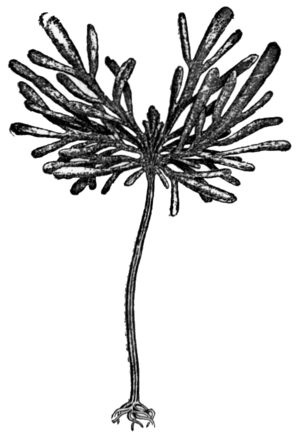Arame facts for kids
Quick facts for kids Eisenia bicyclis |
|
|---|---|
 |
|
| Scientific classification | |
| Genus: |
Eisenia (alga)
|
| Species: |
bicyclis
|
| Synonyms | |
|
Ecklonia bicyclis |
|
Arame (荒布, Eisenia bicyclis, syn. Ecklonia bicyclis), also called sea oak, is a type of kelp. It is a kind of brown algae and is well-known for being used in Japanese cuisine.
Description
Arame, or Eisenia bicyclis, naturally grows in the cool waters of the Pacific Ocean. It is found mostly near Japan, but it is also grown on purpose in places like South Korea. This seaweed grows and reproduces at certain times of the year.
It has two flat, oval-shaped fronds (like leaves) that grow from a strong, woody stem. This stem can be about 1 meter (3 feet) tall. The old fronds fall off each year, and new ones grow back. The plant looks like it has both branches and feathers. People can collect arame by hand while diving or by using machines. You can buy dried arame all year long.
Cooking with Arame
Arame is one of many types of seaweed used in Asian cooking.
You usually buy arame when it is dry. It becomes soft very quickly when you add water, usually in about five minutes. Arame looks like dark brown strands. It has a mild, slightly sweet taste and a firm texture. People add it to many different foods. These include appetizers, casseroles, muffins, and soups. Its mild flavor means it can be used in many recipes.
What's Inside Arame
Arame is full of good things for your body. It has a lot of calcium, iodine, iron, magnesium, and vitamin A. It also gives you many other important minerals.
This seaweed is also collected for other uses. It can be used to make alginate, which is a thickener. It is also used in fertilizer and for iodide. Arame contains a special sugar called laminarin. It also has a small protein called eisenin, which may help your body's defenses. Scientists are also studying if extracts from this algae can help fight certain germs.
See also
 In Spanish: Eisenia bicyclis para niños
In Spanish: Eisenia bicyclis para niños

